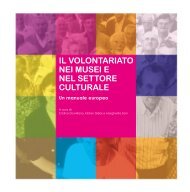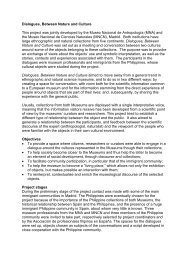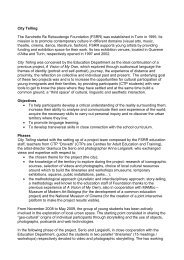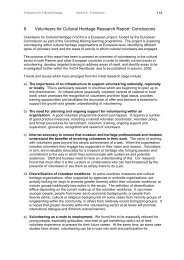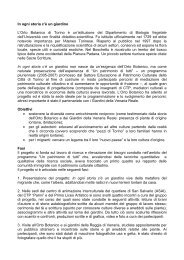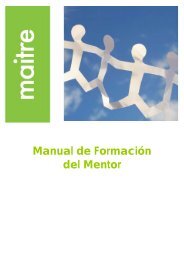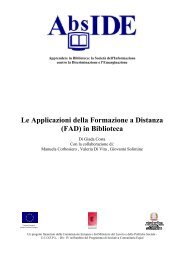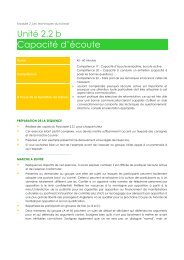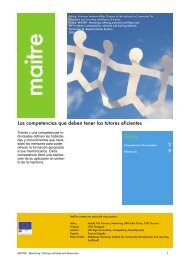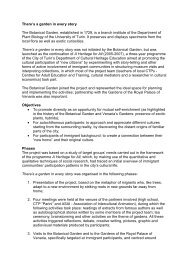Museums as places for intercultural dialogue - Network of European ...
Museums as places for intercultural dialogue - Network of European ...
Museums as places for intercultural dialogue - Network of European ...
Create successful ePaper yourself
Turn your PDF publications into a flip-book with our unique Google optimized e-Paper software.
Talking Objects. This is an innovative learning programme in whichyoung people from diverse backgrounds delve into the history <strong>of</strong>British Museum objects: talking to curators, handling real objectsand debating relevant issues, using drama, dance and other creativeprocesses to expand ide<strong>as</strong>. The aim <strong>of</strong> the programme is to generate aconversation between the young people using the collection, creatinga <strong>dialogue</strong> that is not only a conversation between different people, butalso a <strong>dialogue</strong> with the Museum itself.The Hanging Gardens Exhibition at Swiss Cottage Gallery. In2009 the author worked with five groups from the London Borough<strong>of</strong> Camden to create an exhibition <strong>for</strong> display at the Swiss CottageGallery. Participating groups included an ESOL cl<strong>as</strong>s, an art cl<strong>as</strong>s <strong>for</strong>adults with learning difficulties, a gardening and photography groupfrom a local community <strong>as</strong>sociation, an elders’ art group, and familyvisitors to a local library. The aim <strong>of</strong> the project w<strong>as</strong> to create anexhibition b<strong>as</strong>ed on a re-imagining <strong>of</strong> the Hanging Gardens <strong>of</strong> Babylon,to coincide with the Babylon exhibition at the British Museum. Eachgroup worked on their own interpretation <strong>of</strong> the Hanging Gardens andthe core collection through a variety <strong>of</strong> mediums.Volunteer-led programmes. The Museum h<strong>as</strong> a team <strong>of</strong> nearly500 volunteers, many <strong>of</strong> whom provide valuable support to Learningand Audiences. In addition, volunteer-led programmes such <strong>as</strong> theeyeOpener tours and hands-on object handling sessions attract over15,000 visitors each month. The purpose <strong>of</strong> these programmes is toenable visitors to have a direct and personal experience <strong>of</strong> the Museumthrough touch and talking about objects.Practical considerationsThe British Museum is funded by a combination <strong>of</strong> grant-in aidallocated by Department <strong>for</strong> Culture, Media and Sport (DCMS) andincome secured through a range <strong>of</strong> fund-raising, sponsorship andactivities <strong>for</strong> which a charge is made. 13 Developing sustainableprogrammes is vital to maintaining the critical balance betweeninnovation and quality, and demands <strong>for</strong> incre<strong>as</strong>ed audience access tothe collection. As with any institution, large or small, budgets provided<strong>for</strong> public engagement have to be spent wisely. As far <strong>as</strong> possible, allpilot projects should be conceived with a sustainable component.It is e<strong>as</strong>y to underestimate the amount <strong>of</strong> work involved in deliveringprogrammes such <strong>as</strong> those described above. We have found that it ispossible to achieve this with a relatively small learning team, providedthat they are supported by a range <strong>of</strong> other people, including curators,volunteers, internships, c<strong>as</strong>ual staff, freelance educators, artists,per<strong>for</strong>mers, and musicians. The importance <strong>of</strong> close working withpartners in this context cannot be stressed enough.Much <strong>of</strong> the Department <strong>of</strong> Learning and Audiences’ work is achievedthrough developing strong local, regional, and national partnerships.Successful and strong partnerships are built on trust. Partnershipsshould be mutually beneficial and, where successful, can addadditional resources, capacity, and knowledge to any museum.<strong>Museums</strong> have become more pr<strong>of</strong>icient at partnership working,encouraged by the Inspiring Learning <strong>for</strong> All framework and keysupporting documents such <strong>as</strong> the Learning Revolution (2009), theLearning Power <strong>of</strong> <strong>Museums</strong> (2000), and Understanding the Future:<strong>Museums</strong> and the 21st Century (2005). 14 One <strong>of</strong> the most important<strong>as</strong>pects <strong>of</strong> partnership working is the identification <strong>of</strong> suitable partners.Meeting with local community organisations, further education colleges,support groups and charities can prove a fruitful source <strong>of</strong> potentialpartners. Local government teams and initiatives can also provideuseful networking opportunities.The next step <strong>for</strong> the British Museum is to build on the successesto date, and to continue to place its role <strong>as</strong> a “museum <strong>of</strong> the world”at the heart <strong>of</strong> its thinking and operations. Providing an environmentwhere <strong>intercultural</strong> <strong>dialogue</strong> can take place, where visitors can uncoverthe rich tapestry <strong>of</strong> human history through the collection, is a realisticand sustainable goal.1E. Hooper-Greenhill, <strong>Museums</strong> and Education: Purpose, Pedagogy, Per<strong>for</strong>mance,Routledge, London and New York, 2007, p. 2.2British Museum website (www.britishmuseum.org).3N. MacGregor, “To Shape the Citizens <strong>of</strong> ‘That Great City, the World’”, in J. Cuno,Whose Culture?: The promise <strong>of</strong> museums and the debate over antiquities, PrincetonUniversity Press, Princeton and Ox<strong>for</strong>d, 2009, p. 39.4British Museum website.5The British Museum Strategy to 2012, 2008, p. 5 (www.britishmuseum.org/pdf/Strategy%20to%202012%20web%20version.pdf).6N. FitzGerald KBE, “Chairman’s Foreword”, in British Museum Review 2007/2008, p.4 (www.britishmuseum.org/pdf/annualreview0708.pdf).7E. Hooper-Greenhill, <strong>Museums</strong> and Education: Purpose, Pedagogy, Per<strong>for</strong>mance,Routledge, London and New York, 2007, p. 12.8The British Museum Strategy to 2012, 2008, p. 10.9See <strong>for</strong> example E. Hooper-Greenhill, <strong>Museums</strong> and Education: Purpose, Pedagogy,Per<strong>for</strong>mance, Routledge, London and New York, 2007.10See www.inspiringlearning<strong>for</strong>all.gov.uk <strong>for</strong> a definition on learning.11PocketVisions is an independent film unit set up by anthropologists from UCL (UniversityCollege London).12British Museum Review 2008/2009, p. 60.13The British Museum Reports and Accounts <strong>for</strong> the year ended 31 March 2008.14See DIUS, The Learning Revolution White Paper, 2009; DCSF/DCMS, The LearningPower <strong>of</strong> <strong>Museums</strong>: A Vision <strong>for</strong> Museum Education, 2000; DCMS, Understanding theFuture: <strong>Museums</strong> and 21st Century Life, 2005. For a good summary on partnershipworking, read chapter 6 <strong>of</strong> G. Fincham and J. Ward, Inspiring Adults. Literacy, languageand numeracy in the museums, libraries and archives sector, NIACE, Leicester, 2006,alongside the DCMS publications mentioned above.16 17



